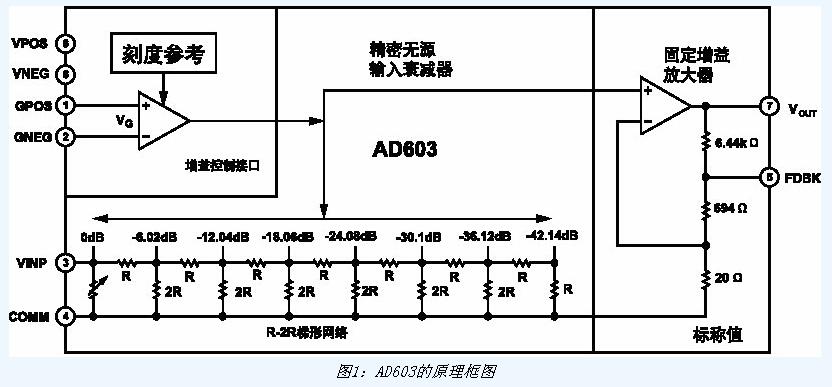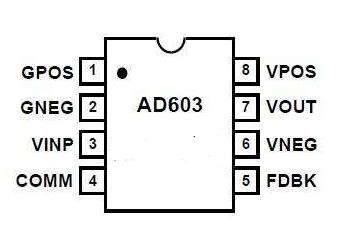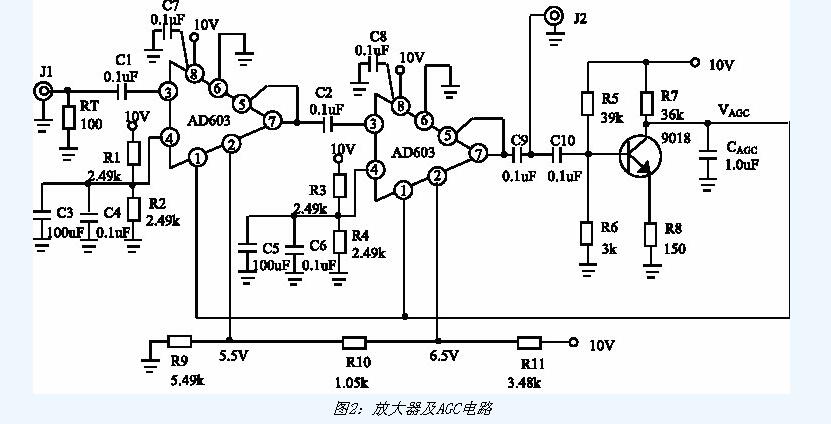At present, there are mainly two methods for controlling the amplifier gain in a shortwave receiver. One is to change the parameters of the amplifier itself to change the gain. Typically, a double-gate FET is used. The gain is changed by changing the dc bias voltage of one of the gates; the other is to insert the amplifier between the amplifier stages. The variable attenuator controls the amount of attenuation and changes the gain. Typically, various variable gain amplifiers are integrated. The AGC circuit discussed in this paper is implemented using Analog Devices' AD603 variable gain amplifier combined with a simple AGC control circuit. The required gain is greater than 50dB, the AGC dynamic range is greater than 65dB, and the output signal level is basically stable at -10dBm. The AD603 is a low-noise, 90MHz bandwidth-tunable integrated op amp. If the gain is expressed in decibels, the gain is linear with the control voltage. The connection mode between the pins determines the programmable gain range. The bandwidth is 90MHz when the gain is between -11 and +30dB. The gain has a 9MHz bandwidth when it is between +9 and +41dB. The connection resistance between the pins is changed, and the gain can be increased. Within the above range. The integrated circuit can be applied to RF automatic gain amplifiers, video gain control, A/D conversion range expansion and signal measurement systems. The simplified block diagram is shown in Figure 1. Table 1: AD603 Pin Function The AD603 consists of a passive input attenuator, a gain control interface, and a fixed gain amplifier. The signal added to the input of the ladder network (VINP) in the figure is attenuated and output by the fixed gain amplifier. The attenuation is determined by the voltage applied to the gain control interface. Gain adjustment has nothing to do with its own voltage value, but only with its difference VG, because the control voltage GPOS / GNEG end input resistance is as high as 50MΩ, so the input current is very small, resulting in the on-chip control circuit to reduce the external circuit that provides the gain control voltage small. The above characteristics are very suitable for forming a programmable gain amplifier. The "sliding arm" in Fig. 1 can be connected and moved from left to right. When the connection between VOUT and FDBK is different, the gain range of the amplifier is different. When pin 5 and pin 7 are shorted, the gain of AD603 is 40Vg+10. At this time, the gain range is between -10 and 30dB. The design of this paper is applied in this way. When pin 5 and pin 7 are disconnected, the gain is 40Vg+30, and the gain range is 10~50dB. If resistors 5 and 7 are connected, the gain range will be between the two. ◠How the AGC circuit works The AD603 is selected as the main amplifier. Two AD603s are cascaded in order to fully utilize the gain control function of each AD603. The AGC detection is completed by 9018, and the 9018 sends out the AGC control voltage at the same time. The complete amplifier and AGC circuit are shown in Figure 2. After the signal amplified by the two stages of AD603, a route J2 is sent to the next signal channel, and another channel is input by C10 to 9018 for AGC detection. The emitter PN junction of 9018 completes the AGC detection and is filtered by the collector CAGC to send out the AGC control voltage VAGC. When the input signal increases, the base current of 9018 increases, and the corresponding collector current also increases, so that the instantaneous voltage drop across R7 also increases, the collector instantaneous voltage decreases, and the filtered voltage is obtained. The VAGC also decreases accordingly; similarly, when the input signal decreases, the VAGC increases, that is, the VAGC is inversely proportional to the strength of the input signal and meets the AGC voltage inversion control requirement. The AD603's pin 2 pressure drop is fixed, and the voltage drop from pin 1 to ground is VAGC, so that the voltage difference V12 between pins 1 and 2 is controlled by VAGC. The gain of AD603 can be expressed as: G=40·V12+10. It can be seen that with the increase of VAGC, V12 also increases, then the gain of AD603 becomes larger; conversely, if VAGC decreases, V12 also decreases, then the gain of AD603 becomes smaller, so that the output of two stages of AD603 is constant at a certain Signal strength. The adjustment of the AGC time constant can be achieved by changing the CAGC's capacitance. ◠AGC gain allocation and calculation The use of sequential cascading modes for the two AD603s facilitates control accuracy and signal-to-noise ratio improvement. The sequential cascading mode requires that the gain of the first AD603 is first enabled when the signal is amplified, and then the gain of the second chip is used after exhaustion. According to the gain calculation formula of AD603, when V12 is between -500 and 500mV, its gain varies from -10 to 30dB, then there should be a voltage difference of 1V between two AD603's V12, as shown in Figure 2. There is a voltage drop of 1V between the two AD603's 2 feet. According to the actual design should have a certain margin. By setting the gain range of the first AD603 to -6 to 30 dB, the corresponding V12 is -400 to 500 mV, and its 2 feet are already fixed at 5.5 V. Therefore, the control voltage of 1 foot, VAGC, should be 5.1 to 6 V. The gain range of the second AD603 is set to -10~24dB, and the corresponding V12 is -500~350mV, and the 2 feet are fixed at 6.5V. Therefore, the control voltage of 1 foot is VAGC should be 6~6.85V. The total gain range after cascade connection is -16 to 54 dB, as shown in Figure 3. From the above analysis, when the AGC control voltage VAGC varies from 5.1V to 6.85V, the total gain of the two-stage AD603 increases linearly from -16dB to 54dB. What needs to be done now is to adjust the operating point of 9018 so that when the input signal changes appropriately, the AGC control voltage VAGC varying from 5.1V to 6.85V can be taken out from the collector of the 9018. As can be seen from Figure 2, the size of VAGC depends on the resistance of R7 and the size of the collector current. When there is no signal input, adjust the static operating point of 9018 so that the PN junction of the 9018 emitter is in an approximate cut-off state, and adjust the resistance of R7 so ​​that the VAGC is 6.85V. At this time, the gains of the two stages of the AD603 are all released, that is, 54dB. When the signal input, but its signal strength can not make the 9018 emitter PN junction conduction, AGC is out of control, the output signal will increase with the input signal strength increases; when the signal strength is enough to make the 9018 launch When the PN junction of the pole is on, 9018 is in the AGC detection state. At this time, the AGC starts to control and the VAGC decreases at a rate of about 25 mV/dB until it drops to 5.1V. The gain of the corresponding two-stage AD603 also starts to gradually decrease from 54dB to -16dB. First, the gain of the second stage AD603 gradually decreases from 24dB to -10dB, and then the gain of the first stage AD603 also gradually decreases from 30dB to -6dB. At this point, when the AGC enters the saturation point and the input signal strength increases, the AGC has lost its control function, and the output signal will increase as the input signal strength increases. This is the entire control process of the AGC, ie, as the input signal strength continues to increase, the AGC will experience a loss of control, start of control, saturation, and loss of control again. ◠Selection and calculation of AGC control point and saturation point The selection of AGC control point and saturation point should be calculated according to the specific application. Assume that after the signal is amplified by the AGC, the signal strength is stable at W (dBm), and the AGC gain range is Ga to Gb (dB). Then the AGC control point level (dBm) is W-Gb; the AGC saturation point level ( dBm) is W-Ga. In the application, after the signal is amplified by the two-stage AD603, its signal strength is basically stable at -10dBm, and the AGC gain range is -16 to 54dB, so the AGC starting control point level should be -10-54=-64 ( dBm); AGC saturation point level should be -10-(-16)=6(dBm). Therefore, the dynamic range of signals that AGC can handle is -64 to 6 dBm, a total of 70 dB. The AGC control point can be adjusted by changing the resistance of R5. In fact, changing the resistance of R5 is adjusting the voltage drop of the 9018 emitter's PN junction. When this PN junction is used for AGC detection, its voltage drop is approximately biased between 500 and 700 mV. Assuming that the instantaneous voltage drop of this PN junction is 600mV during operation, the AGC starts to control and assumes that the required AGC starting point is -30dBm (20mV). Then, the PN can be adjusted by adjusting the resistance of R5. The junction is biased at 580mV. When the input signal level reaches 20mV, the instantaneous voltage drop of this PN junction is 600mV, and the AGC starts to control. The above is only a qualitative approximate analysis. In actual circuit implementation, it is necessary to adjust the resistance of R5 repeatedly according to the measurement result, so as to meet the requirements of the AGC starting control point. Of course, there is a lower limit for the AGC control point. In terms of the AGC control circuit shown in Fig. 2, the lower limit of the AGC control depends on the adjustment accuracy of the 9018 emitter PN junction voltage drop, which is about 100 μV (-76 dBm) in actual measurement. Experimental data The entire circuit is connected as shown in Figure 4 for closed-loop testing. During the test, the input signal strength was changed by adjusting the HP-8920A's variable attenuator. The output signal strength was observed by the HP-E4405B. At the same time, the voltage of the VAGC was tested by a multimeter. The test data is shown in Table 2. From the test data in Table 2, it can be seen that when the input signal strength changes from -64dBm to 6dBm, the AGC control circuit can adjust the size of the AGC control voltage VAGC accordingly, thereby changing the gain of the AD603 so that its output signal strength is basically stable at - 10dBm, the entire control range is above 70dB, to meet the design requirements. Household Electrical Appliances gree , https://www.greegroups.com





